Want to know how to make your product photos stand out and boost sales? Looking for the best ecommerce photo editing software to enhance your images effortlessly?
If you run an online store then you already know that high-quality product photos can make or break your success. Shoppers can’t touch or try your products, so your images do all the selling.
In fact, 75% of online buyers say product photos influence their purchase decisions. That means poorly edited and low-quality images could be costing you sales.
But here’s the good news: You don’t need to be a professional photographer to create eye-catching product images. With the best photo editing software for ecommerce, you can:
✅ Remove unwanted backgrounds for a clean, professional look
✅ Adjust brightness, contrast, and colors to make products pop
✅ Resize and optimize images to load faster on your website
✅ Retouch blemishes and imperfections for a flawless finish
If you’re an ecommerce store owner, dropshipper, small business, or product photographer then this guide is designed to help you find the best ecommerce photo editing software for your needs.
There are tons of tools out there, and choosing the right one can be confusing. That’s why I’ve done the research for you!
What You’ll Get in This Guide
I’ll walk you through the 15 best ecommerce photo editing software options, covering:
✔️ Key features – What makes each tool great for product images
✔️ Pros and cons – The strengths and limitations of each software
✔️ Pricing – Free options and paid plans to fit your budget
✔️ Best for – Whether it’s ideal for beginners, pros, or budget-conscious sellers
By the end of this guide, you’ll know exactly which photo editor fits your needs, saves you time, and helps you sell more.
Now that you know why image editing is essential, let’s dive into the best photo editing software for ecommerce to make your product photos look amazing. Keep reading! 🚀
The 15 Best Ecommerce Photo Editing Software
If you want to create high-quality product images, then choosing the right photo editing software is crucial. Below, I’ll go over the best ecommerce photo editing software. I will cover key features, pros, cons, pricing, and who it’s best suited for.
1. Adobe Photoshop
The industry standard for professional product editing.
If you need full control over product images then Adobe Photoshop is the go-to software. It’s packed with advanced tools that allow you to remove backgrounds, retouch product images, and create high-end visuals for your store. Most professional ecommerce brands and photographers use Photoshop because it offers the most powerful editing options available.
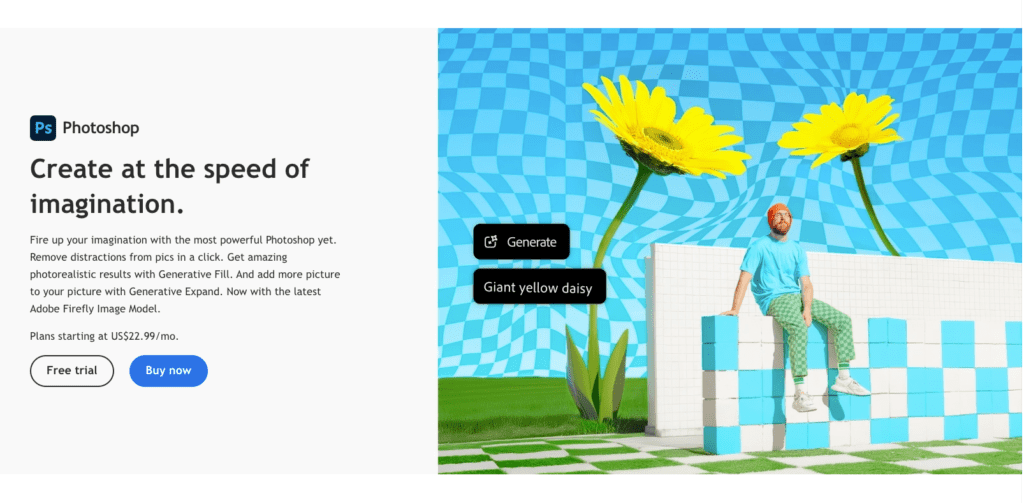
Key Features of Adobe Photoshop:
✔️ Layer-based editing – Work on different elements separately for precision
✔️ Background removal – Use AI-powered selection tools for fast edits
✔️ Retouching tools – Remove dust, scratches, and imperfections
✔️ Smart Objects – Keep image quality intact when resizing
✔️ Batch editing – Save time when editing multiple product photos
Pros of Adobe Photoshop:
✅ Most powerful software for product photo editing.
✅ Supports high-resolution images without quality loss.
✅ Advanced tools for background removal and retouching.
Cons of Adobe Photoshop:
❌ Steep learning curve for beginners.
❌ Expensive compared to other options.
Best For:
📌 Professional ecommerce brands & photographers who need high-end product images.
Pricing of Adobe Photoshop:
💰 $20.99/month (Adobe Creative Cloud subscription).
Best AI photo retouching software
2. Adobe Lightroom
Best for quick, high-quality photo adjustments.
If you don’t need Photoshop’s advanced retouching tools then Adobe Lightroom is a great alternative. It’s perfect for color correction, exposure adjustments, and batch editing, making it ideal for ecommerce sellers who need to process large numbers of photos quickly.
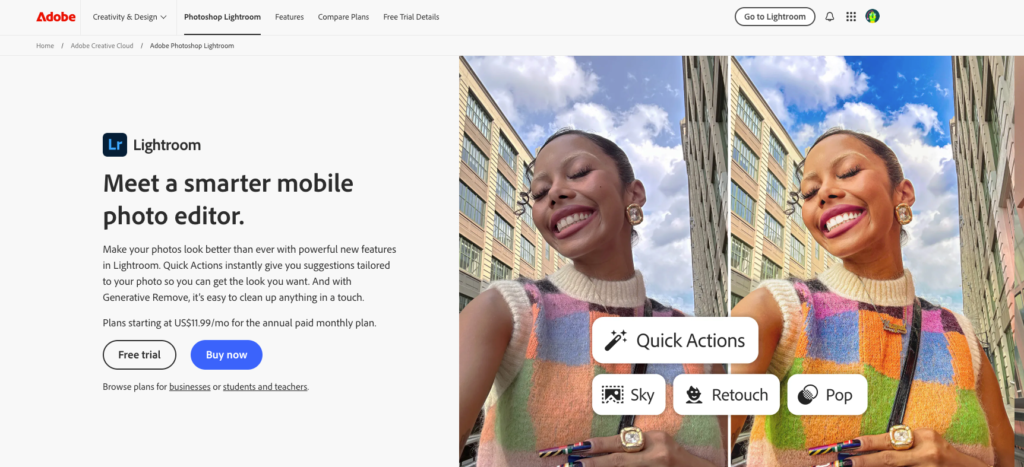
Key Features of Adobe Lightroom:
✔️ Preset filters – Apply consistent styles to all product images
✔️ Batch editing – Edit multiple photos at once to save time
✔️ AI-powered adjustments – Enhance images automatically
✔️ Cloud storage – Access your edits from any device
✔️ Mobile app – Edit product photos on the go
Pros of Adobe Lightroom:
✅ User-friendly interface, easier to learn than Photoshop.
✅ Fast batch processing for large collections of images.
✅ Syncs across desktop and mobile devices.
Cons of Adobe Lightroom:
❌ Lacks advanced editing features like layer-based editing.
❌ Limited retouching tools compared to Photoshop.
Best For:
📌 Ecommerce sellers needing fast, professional-looking color corrections.
Pricing:
💰 Starts at $9.99/month (Adobe Photography Plan).
How to Edit Product Photos for Ecommerce – Complete Guide
3. Canva
Great for beginners & social media ecommerce stores.
If you want easy, drag-and-drop photo editing then Canva is a fantastic choice. It’s ideal for beginners, print-on-demand sellers, and small businesses that need quick edits without a steep learning curve. It also offers pre-made templates for social media, making it great for ecommerce brands that promote products on Instagram, Facebook, and Pinterest.
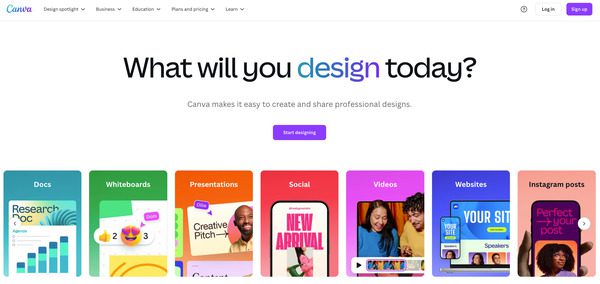
Key Features of Canva:
✔️ Drag-and-drop editing – No advanced skills required
✔️ Background remover – Remove backgrounds with one click (Pro version)
✔️ Pre-made design templates – Ideal for social media marketing
✔️ Text and graphic overlays – Customize product listings with branding
✔️ Collaboration tools – Work with a team in real-time
Pros of Canva:
✅ Super easy to use – no graphic design skills needed.
✅ Affordable and includes free plan.
✅ Great for creating marketing materials alongside product photos.
Cons of Canva:
❌ Limited advanced editing tools.
❌ Not ideal for professional-level retouching.
Best For:
📌 Small businesses, print-on-demand sellers, and social media marketers.
Pricing:
💰 Free, Pro version costs $12.99/month
How to Add White Background on Ecommerce Photos Quick
4. GIMP (GNU Image Manipulation Program)
Free, open-source alternative to Photoshop.
If you need a free photo editing software that can handle advanced image editing then GIMP is one of the best options. It includes many Photoshop-like tools, including layer editing, color correction, and background removal. However, the interface isn’t as polished, and it doesn’t support cloud storage.

Key Features of GIMP:
✔️ Layer-based editing – Similar to Photoshop but free
✔️ Advanced selection tools – Remove backgrounds with precision
✔️ Customizable interface – Add or remove features based on needs
✔️ Supports various file formats – Works with PSD, PNG, JPEG, and more
Pros of GIMP:
✅ Completely free with no hidden costs..
✅ Offers advanced editing tools similar to Photoshop.
✅ Highly customizable with plugins.
Cons of GIMP:
❌ Steeper learning curve compared to beginner-friendly tools..
❌ No built-in cloud storage or mobile app.
Best For:
📌 Budget-conscious ecommerce sellers who need a powerful, free editor.
Pricing:
💰 Free
How to create advertising photos for my ecommerce clothing store
5. Pixlr
Web-based editor with AI-powered tools.
If you prefer a browser-based editor then Pixlr is a great option. It offers AI-powered background removal, making it perfect for dropshippers and print-on-demand sellers who need quick edits. You don’t need to install any software, and it runs on both desktop and mobile devices.
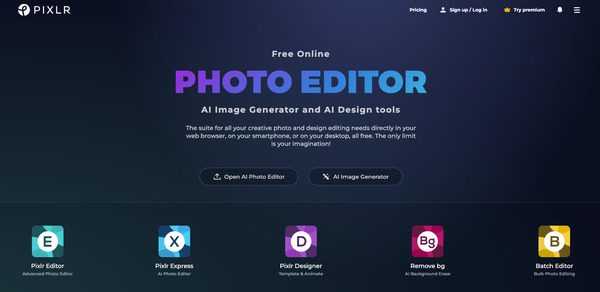
Key Features of Pixlr:
✔️ AI-powered background removal – Removes backgrounds in one click
✔️ Filters and effects – Enhances product images easily
✔️ Retouching tools – Smooths out imperfections
✔️ Web-based – No need to download software
✔️ Mobile compatibility – Edit on the go
Pros of Pixlr:
✅ No installation required – works directly in your browser.
✅ AI-powered tools for fast product photo edits.
✅ Easy to use with a clean interface.
Cons of Pixlr:
❌ Ads in the free version.
❌ Not as powerful as Photoshop for advanced editing.
Best For:
📌 Dropshippers & print-on-demand sellers who need fast, AI-powered editing.
Pricing:
💰 Free, Pro starts at $4.90/month
How to Take Ecommerce Photos According to Experts
We’ve covered five top ecommerce photo editing tools, but there are 10 more great options to explore! Keep reading to find the perfect software for your needs.
6. Fotor – AI-Powered Editor for Quick Enhancements
If you want fast and easy photo editing then Fotor is a great option. It’s AI-powered, meaning it can automatically enhance product images with just one click. This makes it perfect for ecommerce sellers who don’t have time for manual editing but still want professional-looking results.
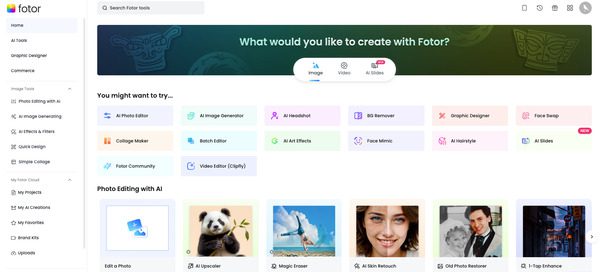
Key Features of Fotor:
✔️ One-click retouching – Enhances brightness, sharpness, and colors instantly
✔️ HDR effects – Creates high-quality product images with balanced exposure
✔️ Batch processing – Edits multiple images at once to save time
Pros of Fotor:
✅ Beginner-friendly – No advanced skills required.
✅ AI-powered tools for fast results.
✅ Supports multiple image formats.
Cons of Fotor:
❌ Limited customization – Less control over manual edits.
❌ Watermarks on free version.
Best For:
📌 Ecommerce sellers who need quick edits without advanced editing knowledge.
Pricing:
💰 Free, Pro starts at $8.99/month
If you want a simple and efficient way to edit product images, Fotor is worth trying. It’s great for basic retouching but might not be ideal if you need full control over every detail.
How Product Photos Improve Ecommerce and Increase Sales
7. Snapseed – Google’s Mobile Photo Editor
If you prefer editing product images on your phone then Snapseed is one of the best free options. Developed by Google, it offers powerful tools in a simple interface. Unlike other mobile editors, it gives you pro-level control over color, exposure, and selective edits.
Key Features of Snapseed:
✔️ Selective adjustments – Edit specific areas of an image
✔️ Professional filters – Apply high-quality presets for quick edits
✔️ Non-destructive editing – Make changes without losing original quality
Pros of Snapseed:
✅ Free – No hidden costs
✅ Works on both Android and iOS
✅ Powerful tools usually found in desktop software
Cons of Snapseed:
❌ No batch editing – Can’t edit multiple images at once
❌ Lacks background removal tools
Best For:
📌 Sellers who edit ecommerce photos on the go.
Pricing:
💰 Free
Snapseed is great if you shoot product photos on your phone and need a quick way to edit them. However, if you need batch processing or advanced retouching, you might want to try a desktop tool instead.
How to edit photos of clothing for an ecommerce site – 12 Best Ways
8. Remove.bg – AI-Powered Background Remover
If you sell products online then you know how important clean backgrounds are. Remove.bg is an AI-powered tool that removes backgrounds in seconds. This is perfect for product photography, especially for platforms like Amazon, eBay, and Shopify, where white backgrounds are required.
Key Features of Remove.bg:
✔️ Automatic background removal – No manual selection needed
✔️ High precision AI – Detects even complex edges like hair or fur
✔️ Bulk processing – Remove backgrounds from multiple images at once
Pros of Remove.bg:
✅ Fast – Removes backgrounds in seconds.
✅ Accurate – Works well on product images.
✅ Easy to use – No editing skills required.
Cons of Remove.bg:
❌ Limited editing tools – No manual fine-tuning.
❌ Credits required for high-resolution downloads.
Best For:
📌 Product image background removal for ecommerce.
Pricing:
💰 Free, Paid plans start at $9/month
If you need quick background removal, Remove.bg is a lifesaver. However, if you need manual adjustments, you may want to use Photoshop or another advanced tool.
11 Best Photo Editing App for Ecommerce Sellers of All Levels
9. BeFunky – Simple Yet Powerful Online Photo Editor
BeFunky is a web-based photo editor that offers a mix of basic and advanced tools. It’s perfect for small ecommerce stores that need quick touch-ups, background removal, and batch processing without a steep learning curve.
Key Features of BeFunky:
✔️ Retouching tools – Smooth skin, remove blemishes, and enhance details
✔️ One-click background removal – Works well for product images
✔️ Batch processing – Edit multiple images at once to save time
Pros of BeFunky:
✅ Affordable compared to other editing tools
✅ Simple interface – Easy for beginners
✅ Good balance of basic and advanced tools
Cons of BeFunky:
❌ Lacks advanced features like Photoshop
❌ Free version has limited options
Best For:
📌 Small ecommerce stores looking for an easy online photo editor.
Pricing:
💰 Free, Pro starts at $4.99/month
BeFunky is great if you need an affordable, user-friendly editor. It’s not as advanced as Photoshop, but it gets the job done for most ecommerce needs.
How Important is Product Photography and Image Editing in Ecommerce
10. Photopea – Free Browser-Based Photoshop Alternative
If you need a free alternative to Photoshop then Photopea is a great option. It runs directly in your browser, so you don’t need to download or install anything. It even supports PSD files, making it a fantastic choice for sellers who need advanced edits without paying for Photoshop.
Key Features of Photopea:
✔️ Advanced tools – Supports layers, masks, and smart objects
✔️ PSD editing – Open and edit Photoshop files
✔️ Works on any device – No installation required
Pros of Photopea:
✅ Free to use
✅ No need to install software
✅ Great for advanced editing
Cons of Photopea:
❌ Slower than Photoshop
❌ Ads in the free version
Best For:
📌 Sellers who need a free, online Photoshop alternative.
Pricing:
💰 Free
If you want Photoshop-like features without paying a subscription, Photopea is an excellent choice. It’s slower than Photoshop but perfect for occasional advanced editing.
Best Photo editing tips for eCommerce
11. Luminar Neo – AI-Powered Editor for Stunning Product Images
If you want an AI-powered photo editor that makes your product images stand out then Luminar Neo is a great choice. It’s perfect for ecommerce sellers who want professional-level edits without spending hours fine-tuning details.
Key Features:
✔️ AI Sky Replacement – Great for outdoor product shoots
✔️ One-Click Enhancements – Improve brightness, contrast, and sharpness instantly
✔️ Background Removal Tool – Helps create clean product images for online stores
Pros:
✅ Easy to use – No advanced skills required.
✅ AI-powered tools for quick results.
✅ Supports RAW file editing.
Cons:
❌ Can be slow on older computers.
❌ No batch editing in the basic version.
Best For:
📌 Ecommerce sellers who need high-quality product images without manual effort.
Pricing:
💰 Starts at $79 (one-time payment)
If you want to create professional product images with minimal effort, Luminar Neo is a solid choice. It’s great for color correction, background removal, and AI-based enhancements.
How to Start Ecommerce Photography Business
12. InPixio – Simple Photo Editor with AI Background Removal
If you need an easy-to-use photo editor then InPixio is worth checking out. It’s ideal for small business owners and ecommerce sellers who want quick edits without complicated tools.
Key Features of InPixio:
✔️ AI Background Remover – Removes backgrounds in seconds.
✔️ One-Click Enhancements – Adjust brightness, contrast, and sharpness instantly.
✔️ Photo Montages – Create stunning marketing visuals with ease.
Pros of InPixio:
✅ User-friendly interface.
✅ Great for beginners.
✅ Affordable pricing.
Cons of InPixio:
❌ Limited advanced editing tools
❌ Free version adds watermarks
Best For:
📌 Ecommerce sellers who want quick and simple product photo edits.
Pricing:
💰 Starts at $49.99 (one-time payment)
If you need background removal and simple touch-ups, InPixio is an excellent choice. It’s also great for creating clean product images for Shopify, eBay, or Amazon listings.
How to get into ecommerce photography: Expert Tips Inside
13. PicMonkey – Online Editor for Social Media and Ecommerce
If you sell products online and need eye-catching images for social media and ads then PicMonkey is a fantastic tool. It offers filters, retouching tools, and graphic design features to make your product images look professional.
Key Features of PicMonkey:
✔️ Collage Maker – Create stunning product showcases
✔️ Text & Graphics – Add branding elements to product images
✔️ Retouching Tools – Smooth skin, remove blemishes, and enhance details
Pros:
✅ Perfect for social media and ecommerce graphics.
✅ No need to install software.
✅ Easy to use for beginners.
Cons:
❌ No RAW file support.
❌ Subscription-based pricing.
Best For:
📌 Ecommerce sellers who need product images for ads, social media, and marketing.
Pricing:
💰 Starts at $7.99/month
If you want to create visually appealing product images, PicMonkey is a great choice. It’s perfect for branding, ads, and social media marketing.
How much to charge for ecommerce photography: Complete Guide
14. Affinity Photo – Budget-Friendly Photoshop Alternative
If you’re looking for a Photoshop alternative without the monthly subscription then Affinity Photo is a great pick. It offers professional-grade editing tools at an affordable one-time cost.
Key Features of Affinity Photo:
✔️ RAW Editing – Supports high-quality image editing
✔️ Advanced Retouching – Clone tool, healing brush, and frequency separation
✔️ Layers & Masks – Full control over product photo adjustments
Pros of Affinity Photo:
✅ One-time payment (no subscriptions!).
✅ Advanced editing tools for professionals.
✅ Fast and efficient performance.
Cons of Affinity Photo:
❌ Learning curve for beginners.
❌ No AI-powered tools like Luminar or Fotor.
Best For:
📌 Ecommerce sellers who need professional edits at a budget-friendly price.
Pricing:
💰 One-time payment of $69.99
If you need advanced photo editing without a subscription, Affinity Photo is a fantastic choice. It’s great for detailed product retouching and high-end image editing.
What Is Ecommerce Photography? A Simple Guide for Online Sellers
15. Crello – Design and Photo Editing for Ecommerce Marketing
If you need a mix of photo editing and design tools, Crello is perfect. It’s great for creating product ads, social media posts, and branded visuals.
Key Features:
✔️ Pre-Made Templates – Perfect for ecommerce promotions.
✔️ Background Removal – Create clean product images for online stores.
✔️ Text & Graphics – Add call-to-action elements for better engagement.
Pros:
✅ Great for marketing and product ads.
✅ Easy drag-and-drop interface.
✅ No design skills needed.
Cons:
❌ Limited photo editing tools.
❌ Subscription-based pricing.
Best For:
📌 Ecommerce sellers who need engaging visuals for ads and social media.
Pricing:
💰 Free plan available, Pro starts at $10/month
If you need photo editing and design tools in one platform, Crello is a great option. It’s perfect for creating ads, banners, and marketing materials for your online store.
How to take product photos for ecommerce according to experts
What Makes a Great Ecommerce Photo Editing Software?
If you’re selling online, high-quality product images are essential. Clear, professional-looking photos help build trust and boost sales. That’s why choosing the best ecommerce photo editing software is important. A good tool can enhance images, remove distractions, and make your products stand out.
Key Features to Look for:
- Background Removal & Image Clipping
Clean backgrounds make product images look professional. Tools like Remove.bg and Canva help remove backgrounds in seconds. - Retouching & Enhancement
Fix lighting issues, remove blemishes, and improve colors. Software like Photoshop and Luminar Neo offer advanced retouching features. - Batch Editing for Bulk Images
If you sell multiple products, batch editing saves time. Lightroom and BeFunky allow quick edits for multiple images at once. - Shadow & Reflection Effects
Adding shadows or reflections gives images a realistic touch. This makes products appear more appealing on ecommerce platforms. - AI-Powered Editing
AI-based tools like Fotor and Pixlr provide one-click enhancements, making it easy for beginners to improve product photos instantly.
Investing in image enhancement software helps create eye-catching product visuals. Better photos lead to more engagement and higher conversions.
How to color match images for eCommerce: Complete Guide
Which Photo Editing Software is Right for You?
With so many options, choosing the right tool can feel overwhelming. Here’s a simple breakdown to help you decide:
- Best for Beginners: If you’re new to editing, try Canva, BeFunky, or Fotor. These are easy to use and offer pre-made templates.
- Best for Professional Editing: If you need advanced tools, go for Photoshop, Lightroom, or Affinity Photo. These offer in-depth control over image quality.
- Best for Quick Edits: For fast touch-ups, use Snapseed, Remove.bg, or Pixlr. They are lightweight and efficient.
- Best Free Options: If you’re on a budget, check out GIMP, Photopea, or Snapseed. These free tools offer excellent editing features without any cost.
Pick a software that fits your skill level and editing needs. If unsure, try a free version before committing to a paid plan.
What is the best size for ecommerce product images
Pro Tips for Editing Ecommerce Photos
Even with the best ecommerce photo editing software, knowing how to edit images properly makes a huge difference. Here are some must-follow tips:
- Use a white or transparent background. Marketplace platforms like Amazon, eBay, and Shopify prefer clean backgrounds.
- Adjust brightness, contrast, and sharpness. Enhancing these settings makes images clearer and more appealing.
- Remove unwanted objects. If there are distractions in the background, use tools like Photoshop’s Content-Aware Fill to erase them.
- Meet platform image requirements. Each marketplace has specific image size and resolution rules. Check these before uploading.
- Save images in high-quality formats. Use JPEG, PNG, or WebP to ensure images look crisp without slowing down website load times.
Following these tips improves your product presentation and increases your chances of making more sales.
Need Help With Ecommerce Product Photo Editing Contact Smart Clipping
Conclusion
Using the best ecommerce photo editing software is a smart investment. High-quality product images make your store look professional and increase conversions. If you choose a free tool or a premium software then the goal is the same:
Better-looking product photos = More sales.
If you’re unsure where to start, try free trials of different software. Experiment with features and see which works best for your needs.Now, I’d love to hear from you! Which software are you excited to try? Drop a comment below and let’s discuss!

